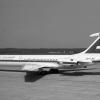Virgin Atlantic A333 near London on Apr 16th 2012, cargo fire indication
The British AAIB released their final report concluding:
Causal factors
The investigation identified that injuries were sustained during the evacuation of the aircraft. The evacuation was initiated based on the commander’s assessment of the available sources of information, including the repetitive and intermittent nature of the aft cargo smoke warnings.
The investigation identified the following causal factor for the intermittent cargo smoke warnings:
- A latent fault on the T1 thermistor of smoke detector 10WH, in combination with a CAN Bus fault and possible high levels of humidity in the cargo compartment due to the carriage of perishable goods, provided circumstances sufficient to generate multiple spurious aft cargo compartment smoke warnings.
Contributory factors
The investigation identified the following contributory factors for the intermittent cargo smoke warnings:
- The thermal channel fault in 10WH was not detected prior to the event by the internal smoke detector temperature monitoring.
- The proximity of the fire extinguisher nozzles to the smoke detectors.
The AAIB reported that two passengers substained serious injuries during the evacuation, the aircraft received minor damage (dents and punctures to fuselage skin panels) as result of the evacuation slides deploying.
The aircraft was climbing through FL187 when the crew received a SMOKE AFT/BULK CARGO SMOKE Master Warning for about 7 seconds, then the indication extinguished, and activated again for about 9 seconds. The third flight crew member offered to go back and check the situation, the commander (49, ATPL, 15,619 hours total, 155 hours on type) contacted dispatch to see whether there were any further details known, e.g. from ACARS messages. Just when he was explaining the problem to dispatch the warning activated again, at which point the commander terminated the call to maintenance, declared PAN and decided to return to Gatwick. The aircraft levelled at FL220 and turned back towards Gatwick. Fire agent was discharged into the cargo hold, the warning activated again for 5 seconds. A second fire agent was discharged, the warning again activated for 5 seconds, after 18 seconds the warning activated again this time for nearly 3 minutes.
The captain briefed the cabin crew to wait for the evacuation command from him, if emergency services did not report any sign of smoke they would taxi in, otherwise they would evacuate.
The third flight crew member returned to the cockpit and reported he had not been able to find any trace of fire, heat or smoke. The fire warning activated again for 11 seconds.
The crew performed an overweight landing into Gatwick's runway 08R and stopped about 1630 meters down the runway with the engines at idle, APU running and park brakes set waiting for information from emergency services. Tower reported "I don't see any smoke from here ... all appears to be normal at this stage."
Fire services contacted the cockpit and asked for the current condition on board, the fire warning again activated. The captain decided to initiate the evacuation at this point, emergency services reported all vehicles were clear, the captain declared Mayday and initiated the emergency evacuation.
The AAIB reported that the emergency services had been told the aircraft had smoke in the cockpit, the emergency services therefore positioned towards the cockpit of the aircraft. When the fire chief contacted the flight crew he was told it was in fact an aft cargo fire indication, a vehicle was repositioned to the rear of the aircraft.
Emergency services subsequently observed the evacuation, passengers were not holding sufficient distance and hit the preceding passengers while those tried to stand up and get sorted off the slide. Others toppled over and fell onto the concrete receiving minor injuries.
After the evacuation had been completed and everybody was confirmed off the aircraft, emergency services opened the cargo hold, removed three palettes to get space and subsequently were able to determine that there had been no smoke, fire or heat. It was noted however that there had been smoke from the brakes of the aircraft after landing.
The AAIB reported that Brest control had received information of "smoke on board", the information was passed on as "smoke in the cockpit" to London Terminal Controller. The Terminal controller's planner, who had just completed his training in unusual circumstances and emergency with a scenario that included an aircraft with suspected fire on board, declared a full emergency for the aircraft as he also believed from garbled transmissions arriving from the aircraft that the crew was on oxygen masks and thus was convinced there was smoke in the cockpit.
The AAIB analysed: "It is difficult for a commander to come to the conclusion that a smoke or fire warning is spurious and make the decision not to evacuate given the life‑threatening implications of being wrong. In this case, the commander decided that the safest course of action was to evacuate the passengers."
The AAIB analysed quoting testimony provided by the captain however, that "simulator training might predispose pilots to make decisions to evacuate when faced with actual circumstances similar to those of a training scenario."
The AAIB analysed: "The message that there was smoke in the aft cargo bay, passed accurately to Brest ATC by the co-pilot, had been corrupted by the time it reached the fire crew at London Gatwick Airport such that they thought there was smoke in the cockpit and positioned their vehicles at the wrong end of the aircraft. Although this had no bearing on events in this incident, it highlighted that it is important for accurate information about the nature of a problem to be relayed between agencies."
The investigation found the thermistors' insulating envelopes of smoke detectors 9 and 10 had been compromised with cracks and holes. The AAIB analysed: "Tests showed that when the thermistor chips came into contact with a conductive substance, such as water, they were unable to detect the correct resistance values for a given temperature, and the resulting temperature measurements were inaccurate. Infiltration of water through the holes or cracks effectively cancelled the insulation provided by the Kapton and PET. The investigation was not able to determine how the integrity of the insulating envelope on the 9WH and 10WH thermistors, had become compromised."
http://avherald.com/h?article=44e15a5f/0000














Komentarze